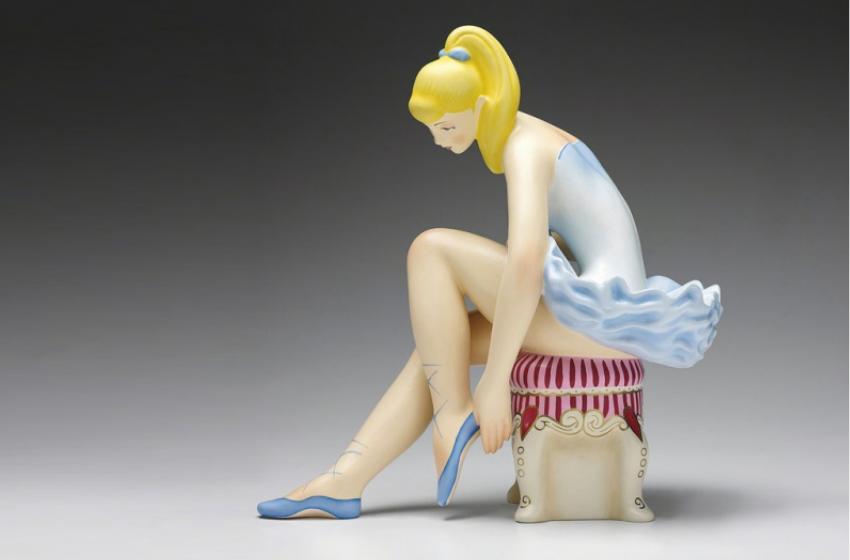In 2017, a scandal in the artistic world arose: Jeff Koons’s “Ballerina Sitting†sculpture, set up on May 12 near Rockefeller Center in New York, is a copy of the work of the Ukrainian craftswoman Oksana Zhnikrup (1931-1993).
Later it became clear that the American artist since 2010 has had the official permission to use two Oksana’s works and even paid royalties: “Ballerinas before the performance†(1961) and “Ballerina Lenochka†(1974) (on the basis of which he created his “Seated Ballerinaâ€). The scandal drew attention not only to the history of the porcelain figurine, but also to Ukrainian art in general.
This is a legal copying of someone else's work. I am sure that my grandmother, as a person with a good sense of humour, would appreciate and laugh heartily at this monster.
Maxim Lozovoy, the grandson of the artist
Oksana Zhnikrup is the author of many such statuettes. In Soviet times, these could be purchased in numerous art salons. Such figures still adorn sideboards and bedside tables in many apartments in various cities of the former Soviet Union. Art critics note that Zhnikrup's style was distinguished by its particular lightness and plasticity. For a long time (from 1955 to 1987) the artist worked at the Kiev Experimental Ceramics and Art Factory, from the assembly line of which in 1974 came off the Ballerina Lenochka.

However, where is the original of the statuette now and what its circulation was, nobody can say. The factory closed in 2006 and its collection disappeared under highly detective circumstances.
The Museum of Decorative Arts now contains 15 works made by Oksana Zhnikrup and her husband Vladislav Shcherbina. There are not so many original works by Zhnikrup itself, and they can be found mainly only in private collections. But museum workers hope that it is thanks to Jeff Koons that the prototype of the sculpture and its author will be recognised in the world. And, perhaps, they will be interested in the work of Oksana Zhnikrup and come to Kyiv, where the story of "Lenochka's Ballerina" began.
Who is Oksana Zhnikrup?
Her biography is not rich in events, but it vividly reflects the tragic fates of many Ukrainians in the twentieth century. She was born on January 31, 1931 in the city of Chita in Transbaikalia, where her grandfather paved roads. His mother is a theater actress, and his father is a civil servant who was arrested in 1937 on espionage charges and sentenced to death. As the daughter of the "enemy of the people" was forbidden to live in Kyiv, Oksana Zhnykrup studied at the Odessa Art School Grekov, after which during 1952-1954 she worked at the Baranovsky porcelain factory.
"The Odessa school had a very high level of teaching. Before the war, it was not a school, but an institute, and with good personnel. Painting, sculpture and drawing were taught by professors. In fact, we studied like at an institute. When I was already in Kyiv at the institute, I did not have such a school as in Odessa..."
The "Baranov" period in the artist's life is marked by an intensive search for themes that are in harmony with her rich inner world. The choice of plots was determined not only by the delicate and gentle nature of the author, but also by the unique atmosphere of theatrical action, which permeated the family life. Theatrical stage, circus arena, graceful ballet dance - all this is wonderfully combined, intertwined in images full of dynamics, fixed movement and gesture. The works of these years ("Cinderella", "Princess Swan", "Indian Dance", "Spanish Dance", "Korean Dance", etc.) are characterized by a rich decoration of chandeliers, gold, the use of a wide range of overglaze paints.



In 1955, Oksana Zhnikrup moved to Kyiv and began work at the capital's Experimental Ceramic and Art Factory (KEKHZ). The "Kyiv" period of her work lasted until 1989. It was here that the creative potential of the sculptor was fully revealed, the original author's style was finally formed, thematic and stylistic searches continued, which ended with reference samples of small porcelain sculpture, which gained worldwide recognition. The artist worked on sculptural works independently or in creative tandem with her husband Vladislav Shcherbina - the leading and later the main artist of the plant.
At that time, the Kyiv plant was, in fact, a kind of creative laboratory, where not only created original products, but also made sketches for many porcelain factories in Ukraine and other union republics, where for many years the works of O. Zhnikrup, V. Shcherbyna, O. Rapay and other authors.



Oksana Zhnykrup was one of the first to abandon the one-line interpretation of the image of a woman in the tradition of the art of socialist realism - a collective worker or a worker, understanding it in the aesthetic plane - as an eternal mystery, beauty and love. The most famous works: "Ballerinas before the performance", "May Night" and "Princess Swan with a Shulik" (1956), "Loves or dislikes" / "Divination on a daisy", "Debut" (1960), "Birch" (1963) , "Yaroslavna", "Sad Girl" / "Such is Her Fate" (1964), cycle "Professions": "Chemist", "Doctor", "Teacher", "Delegate" (1969), "Embroidery" (1971), "The Shepherdess and the Chimney Sweep" (1982).
The list goes on. During this period, the author has created more than a hundred original works. In addition, she worked with V. Shcherbyna on paired compositions "Adagio" (1956), "Nazar Stodolya" (1965), etc., painted not only her own works, but also the works of her husband Vladislav Shcherbyna and her friend Olga Rapay.

Family archive of V. Lozova
The name of the sculptor has been known in art circles since 1958. The real recognition came in 1959, when a small porcelain statuette-toy "Matryoshka" by Oksana Zhnikrup caused a real stir at the international exhibition in Marseille (France), and then in Addis Ababa, Baghdad, Budapest, Bucharest and Tokyo. For the republican jubilee Shevchenko exhibition in 1964, the author developed a thematic sculpture "Sad Girl".
The work took second place in the competition of porcelain products based on the works of Taras Shevchenko and during 1964-1965 represented the original national culture at five international exhibitions and fairs in Greece, Canada, Germany, USA and Yugoslavia. Until 1989, Oksana Zhnykrup was a regular participant in all-Ukrainian, all-Union and international art forums.



The author's thematic preferences remained the same: despite the obligatory official themes, she continued her creative search, revealing herself in the field of theater, ballet and circus art. An important source of inspiration were the national and literary plots of Taras Shevchenko, Lesya Ukrainka, Mykola Gogol ("Banduristka", "Birch", "Sad Girl", "May Night", "Levko and Oksana", "Shoes"). The cycle "Dances of the Peoples of the World" ("Indian Dance", "Georgian Dance", "Kazakh Dance", "Uzbek Dance with Cups", "Spanish Dance. Carmen", etc.), as well as the famous "Ballerina Olenochka" is not easy business card of the artist, and a mandatory component of each collection.


Oksana Zhnykrup's works of the "Kyiv" period are characterised by a clear emphasis on the expressive possibilities of the material itself - porcelain and the minimization of the use of overglaze paints. Sophistication, delicacy, smooth lines, emphasised mystery, lyricism and tenderness, fixed dynamics of movement inherent in the author's works, turn each of them into a small porcelain masterpiece and testify not only to the extremely high level of craftsmanship, but to all Ukrainian decorative art in general.
Officially, the artist's creative biography ended in 1989 (she died on January 13, 1993 after a serious illness), but her works continued to be replicated and accounted for a significant share of the products of porcelain factories in Ukraine. Oksana Zhnykrup herself was and remains the queen of Ukrainian "white gold" - small porcelain sculpture.
In the economic activity of porcelain enterprises, an indicator was used to assess the effectiveness of the creative work of the master - the percentage of work introduced into production to the number created. For Zhnikrup, it is close to 100.

Family photos from the archive of L. Lozova





















